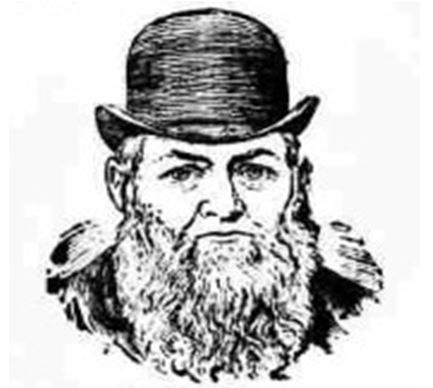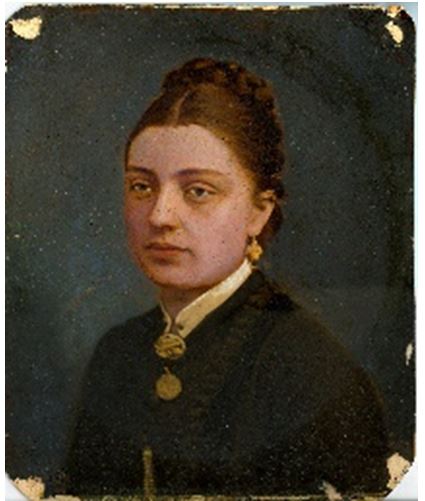
George Rayner - Hoxne resident
' I am 65 years of age, and am generally known as 'Miller Rayner' although I gave up milling some time ago.'
[Born 1836 - Died 1916]
A biography of George Rayner by his great, great, grandson Kevin Knights.
The story of George Rayner, my Great Great Grandfather came to light while I researched our wider family tree. Fortunately there are a large number of online resources available which provided a fuller picture of his life than is often possible to be produced for our ancestors of the Victorian period.
George started life in Hoxne, the son of a shoe maker and for the greater part of his life he continued to live in Cross Street although his final years, according to 1911 Census, has him living in Oakley but dying in Hoxne in 1916 at the grand age of 80. He led an 'interesting' life which was probably the cause of much village gossip!
George Rayner married Mary Hall, from Horham in 1857 and they had two daughters-Mary Eliza (1859) and Florence Alberta (1873). Mary Eliza died at the age of 20 and is interred in Hoxne Churchyard. This portrait of her shows a very well to do young lady. Her grave surround is also of high quality and was once quite imposing.

Her father, George, had continued in the family tradition of shoemaking but also moved on to being a Corn Chandler - selling grain and flour one presumes-and living at the Windmill in Cross Street of which there is now no trace remaining although the cottage is still there end on to the road. George employed one man to help with the work and seems to have traded both within the village and to a wider customer base as he travelled to Diss regularly on Fridays at least.
In 1886 the local paper - Diss Express - and several publications across the country tell us a little more of a 'melancholy occurrence' which happened in The Sun Inn on Mere Street. (Now the Waterfront) It seems that previously to this occurring in March 1886 he had felt threatened by some men, and had a lamp and whip stolen, on his way home and had been offered a revolver which he carried with him on his next visit to Diss. Having left his horse and trap at the Sun Inn he clearly went about his business in the town before returning to the pub.
He met with Arthur Robinson who offered him a drink as they knew each other well it seems. Arthur's daughter, Bessie, came to join them and asked George if he had any treats for her. George took the revolver from his pocket and showed her but unfortunately while doing this it went off with the bullet killing Arthur! George panicked and began running around the pub still waving his revolver until another customer took it from him - although it had gone off again fortunately not hitting anybody this time.
Needless to say George Rayner was arrested and the very next day the County Coroner appeared and swore in a jury who met at the Ship Inn-where Greggs the Bakers is-to decide on the fate of Miller Rayner. The evidence was all clear. George had a revolver. He pulled the trigger. Arthur was killed-in front of his daughter and other witnesses by George Rayner. After careful investigation and cross examination, the verdict, in the words of the jury foreman, was given:
'We find a verdict of Accidental Death arising from the use of a pistol in the hands of a man ignorant of its deadly nature and also ignorant of the way in which to use it: and we think the Coroner should censure him severely for carrying it about.
So George was cleared of blame - other than stupidity!
The following year George had a serious accident while returning home once again from Diss. He was with two companions when his trap hit a 'heap of something lying on the side of the road'. The trap overturned and was left upside down in the road. Mr Phillips, a surgeon from Hoxne was called in and found George with 'no bones broken but one of his hips was much injured and being a very heavy man he was also much bruised and shaken'. One of his companions, Mr Churchyard, was later taken to Norfolk and Norwich Hospital with a dislocated arm while the third person, despite being trapped under the carriage, recovered with barely a bruise to show!
In the next few years George goes from being a Miller and Corn Merchant to merely working for his remaining daughter, Florence, as a Chandler. Florence had a little trouble with this career path but that is another story! George's wife Mary had died in 1895 and his mother in 1900 so he was living with Florence at this time.
George next appears in the press in 1903 when an article which very much appears to be a report of him recovering from the results of an accident which affected him badly which I presume to be when his trap overturned. He also claimed to suffer from serious increasing deafness. On further reading it seems that this article was merely written as an advert for 'Dr Williams' Pink Pills' which George claims not only cured his deafness but also his other problems which had affected his ability to carry heavy weights.
George was listed in 1911 Census as a Boot Repairer on his own account so in his final years he returned-or perhaps had always continued with - his original trade. He died in 1916 and was laid to rest in the churchyard.
There is another strand to George's life however. He is listed in many Directories of the period as a photographer-sometimes as Junior but also Senior. These listings have him variously placed in Hoxne and Scole which is interesting. I think all the listings were him rather than his father who was also a George. But George senior had a middle name of 'Algar' which is the surname of a well-known local Victorian photographer so there is more to discover yet! He does not appear to have had a studio-at least we cannot find any photo frames with his name on - but merely worked as a jobbing photographer. The family have a collection of photographs which may, or may not, have been taken by George. Unfortunately there is no proof either way!
Article written and pictures supplied by Kevin Knights.